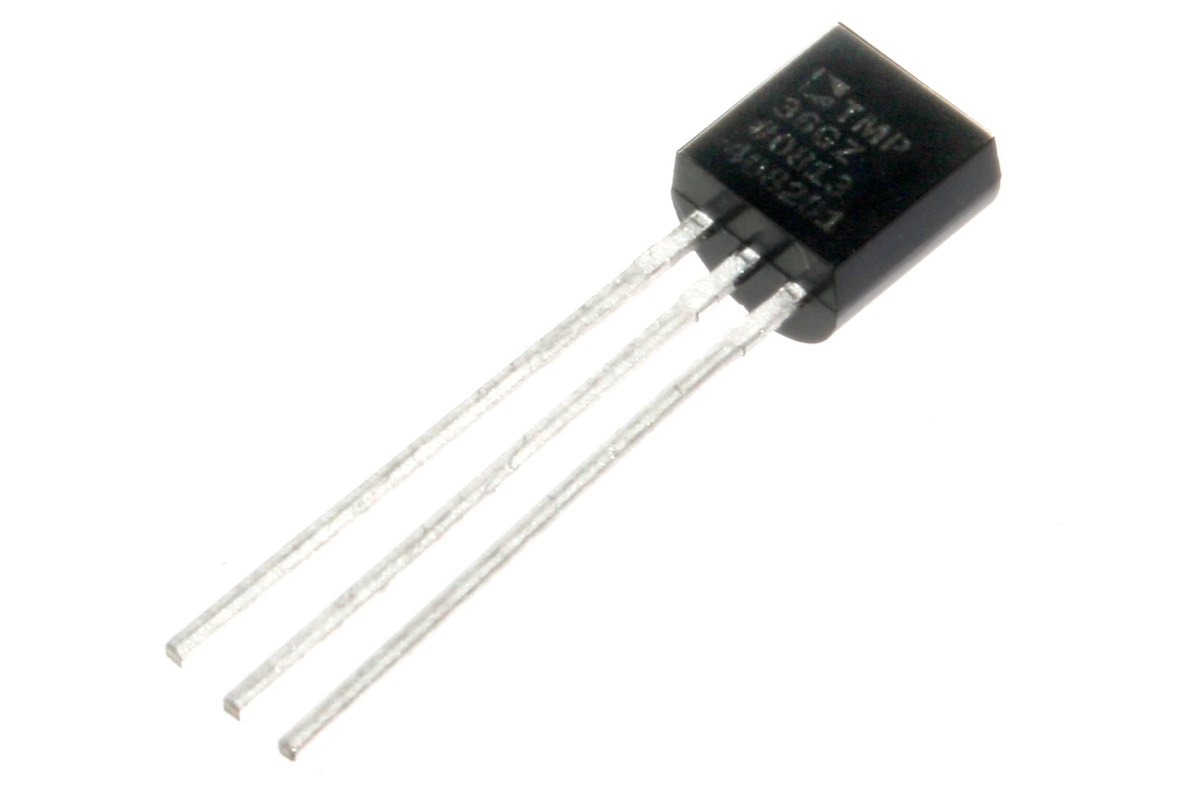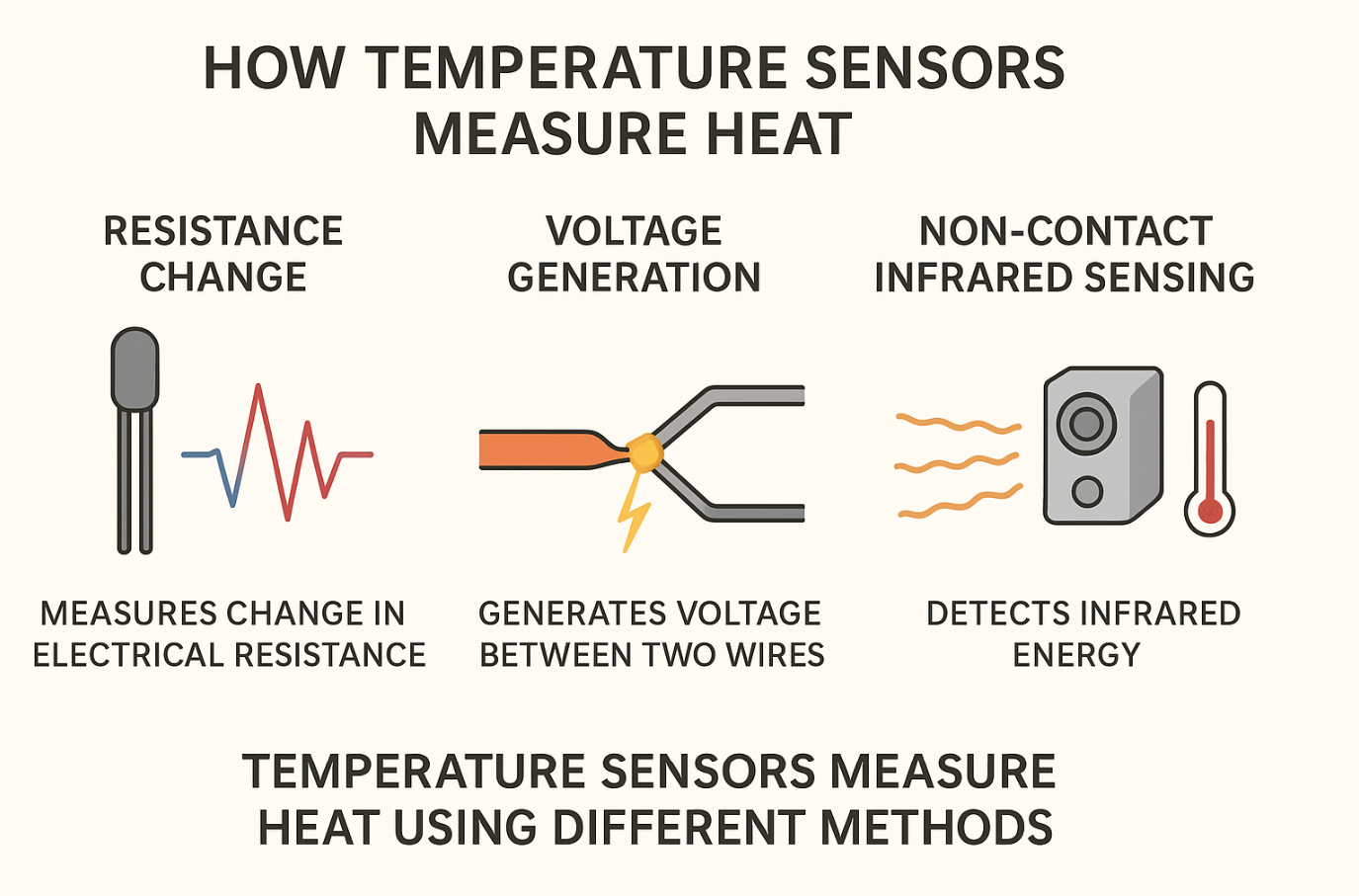What Is a Temperature Sensor?
A temperature sensor is a tool used to measure heat or temperature. It transforms the measurement into a signal that is readable and intelligible. We'll start by going over the fundamentals of how it operates before going over the various kinds of sensors and their applications. Additionally, we will learn how to use Arduino and other basic tools to incorporate temperature sensors into your own projects. We'll conclude by offering some advice to assist you in selecting the ideal temperature sensor for your use case.

How Does a Temperature Sensor Work?
The statement that a temperature sensor measures heat is straightforward. However, how does it accomplish that? The main idea is simple to comprehend. A temperature sensor detects changes in physical objects. When the temperature changes, this physical object changes in a way that we are already aware of. This change is measured by the sensor. After that, it converts the change into an electrical signal. This signal could be either a current or a voltage. A computer or screen can then receive this electrical signal. The signal is read by the computer. It then converts that signal into a temperature value, such as degrees Fahrenheit or Celsius. Temperature is measured by various types of sensors using various physical objects.
Let's examine the primary functions of sensors. Electrical resistance is one popular method. The resistance of certain materials varies with temperature. This simply means that when they get hotter or colder, electricity moves through them more or less easily. At a specific temperature, a sensor composed of this type of material will exhibit a particular resistance. A small amount of electricity can be sent through the sensor by a device. The resistance is then measured by the apparatus. The device is aware of the relationship between temperature and resistance for that particular material. Thus, the gadget is able to determine the precise temperature. This is how two widely used types of sensors operate. They are referred to as thermistors and RTDs.
Sensors can also generate their own voltage. This effect is really well done. It occurs when two types of metal wires are connected at one end. A tiny voltage is created between the two wires when the joined end heats up. The temperature has a direct impact on how much voltage it produces. The voltage is higher if the joined end is hotter. A thermocouple is a type of sensor that employs this technique. Their ability to measure a wide range of temperatures makes them popular. They are also very powerful.

There is a third method of measuring temperature that does not require any physical contact with the object. We refer to this as non-contact temperature sensing. Energy is released by any object that has a temperature. This energy is known as infrared energy or thermal radiation. This energy is invisible to the naked eye. However, it feels like heat to us. A specialized lens is used in infrared temperature sensors. This energy is directed toward a component known as a detector by the lens. After that, the energy is converted into an electrical signal by the detector. We can determine the temperature of an object by measuring the energy it detects. This enables the sensor to detect temperature at a distance. This is very useful for measuring extremely hot objects. It is also useful for measuring objects in difficult-to-reach places or those that are moving.
Therefore, heat is measured by all temperature sensors. However, their methods differ. Resistance changes are used by some. Others create their own voltage. Some people can also see the heat energy that objects emit, which is invisible. We can better comprehend why we have so many different types of sensors if we grasp these basic concepts.
The Main Kinds of Temperature Sensors and Their Uses
Sensors function using a variety of electronic components. Thus, temperature sensors come in a variety of primary types. Each type has strengths and weaknesses. They can therefore be used for a variety of tasks. A few factors determine which one is best. The temperature range you need to measure must be considered. You must consider how precise you require the measurement to be. Additionally, you must consider the amount of money you wish to spend. Let's discuss the most widely used types of sensors.
Thermocouples:
Principle: Two different metal wires joined at one point, generating a small voltage when heated or cooled.
Key Features: Very large temperature range (hundreds below zero to over 2000°C), very robust, inexpensive.
Applications: Industrial settings, furnaces, kilns, jet engines, chemical factories – ideal for high temperatures in tough conditions.
Resistance Temperature Detectors (RTDs):
Principle: Measure changes in electrical resistance of a metal (typically platinum) as temperature changes. Resistance-temperature relationship is very stable and predictable, often linear.
Key Features: High accuracy, high stability, consistent measurements over time.
Applications: Science labs, food factories, medical tools – critical when very precise temperature is needed. (More expensive than thermocouples.)
Thermistors:
Principle: Also use electrical resistance, but made from ceramic or polymer materials, not pure metals. Resistance changes significantly with small temperature changes (high sensitivity).
Key Features: High sensitivity to small temperature changes, small size, inexpensive.
Applications: Normal temperature ranges (house, body), digital thermostats, refrigerators, ovens, digital thermometers. (Smaller temperature range than thermocouples or RTDs.)
Infrared Sensors:
Principle: Non-contact sensors that measure heat radiation emitted from an object's surface.
Key Features: Speed, safety, non-contact measurement.
Applications: Moving parts on machinery, checking electrical boxes safely, food on a belt, quickly checking body temperature.
Summary:
Each sensor type has a specific role:
Thermocouples: For very high temperatures and harsh conditions.
RTDs: For the most exact and stable readings.
Thermistors: For sensitive measurements in everyday temperature ranges.
Infrared Sensors: For quick, safe, non-contact measurements from a distance.
A Fun Project: Using a Temperature Sensor with Arduino
For people who like to build things, like students and hobbyists, there is a great tool called Arduino. An Arduino is a small computer board that is easy to use. It lets you build and control your own electronic projects. One of the most common first projects is to connect a sensor. This lets you get a reading from the world around you. Using a temperature sensor with an Arduino is a great way to learn the basics.
Let's think about how you would do this. First, you need an Arduino board and a temperature sensor. You can find many cheap and simple sensors that are perfect for beginners. LM35 or DHT11 sensors are good choices and you can easily find them on Joydo. The DHT11 is great because it can measure both temperature and humidity. These sensors usually have three or four metal legs, called pins. One pin is for power. One pin is for ground, which is the negative connection. And one pin is the data pin. This is the pin that sends the temperature signal to the Arduino.
The next step is to connect the sensor to the Arduino. You would use small wires for this. You connect the power pin on the sensor to the 5V pin on the Arduino. You connect the ground pin on the sensor to a GND pin on the Arduino. Then you connect the data pin on the sensor to one of the digital input pins on the Arduino. The connection is very easy to do.
After the parts are connected, you need to write some computer code. You program the Arduino using a simple language. The code tells the Arduino what to do. The code would first tell the Arduino which pin the sensor is connected to. Then, the code would tell the Arduino to read the signal from that pin over and over again. The sensor sends the temperature information as a digital signal. Your code needs to take that signal and turn it into a temperature number. For many common sensors, you can find free code libraries that do all the hard work for you. You can just use a simple command in your code to get the temperature.
Finally, you need a way to see the result. The easiest way is to send the temperature reading from the Arduino to your computer. The Arduino connects to your computer with a USB cable. Your code can tell the Arduino to print the temperature reading to a special window on your computer screen. This window is called the Serial Monitor. When you run the program, you will see numbers appearing on your screen. These numbers show the current temperature in the room.
This is a simple example. But you can do much more. You could add a small screen to your project to show the temperature. You could add a light that turns on if the temperature gets too high. You could even add a Wi-Fi part. Then your Arduino could send the temperature data to a website on the internet. Using a temperature sensor with an Arduino is a fun and good way to start learning about electronics. It shows you how technology can work with the world around us.
Going Wireless: More and More Wireless Temperature Sensors
It used to be necessary to use a wire in order to measure temperature. The sensor and the gadget that read it were connected by a wire. Many people still do this. Wires, however, can be problematic. Long-distance wire runs can be very expensive. The cables may break. Additionally, there are some locations where running a wire is simply impossible. Thus, wireless temperature sensors have gained a lot of popularity.
Like any other sensor, a wireless temperature sensor operates. However, it has two additional parts. It sends signals using a tiny radio. Additionally, it is powered by a battery. The sensor uses a radio signal to transmit the temperature data through the atmosphere after it has been measured. This signal is detected by a receiver. The receiver can be linked to a network or a computer. This indicates that there is no need for a physical wire to connect the sensor to the system that is monitoring it.
There are many benefits to switching to wireless. They can be installed much more quickly and easily. A sensor can be installed practically anywhere. Cables are not a concern for you. This works well for monitoring large spaces, such as a farm or a large warehouse. Sensors can also be installed on moving objects. One can be placed on a truck that transports cold food, for instance. The sensor has the ability to continuously transmit temperature data to a central system. This keeps the food cold.
A lot of wireless sensors can also detect humidity. An extremely popular gadget is a wireless temperature and humidity sensor. It is utilized in numerous settings where humidity and temperature are crucial. Farmers utilize these sensors to create the ideal growing conditions for plants in greenhouses. They serve to prevent damage to priceless and ancient items in museums. They may suffer from improper humidity or temperature. Thousands of computers are in operation in data centers. In that place, these sensors are crucial. They monitor the surroundings to prevent the computers from overheating. Additionally, they regulate moisture that can damage the electronics.
Wireless sensors use a different kind of technology. To send data to a phone or other nearby device over a short distance, some people use Bluetooth. Some connect directly to the internet via Wi-Fi. They may use specialized networks that use low power and can reach far distances to send data over long distances, such as on a farm.
How to Choose the Right Temperature Sensor for Your Job
There are so many kinds of temperature sensors. So, choosing the right one can feel hard. But if you think about what you need, you can make a good choice. You just need to ask yourself some important questions.
What temperature range do you need to measure first? Usually, this is the most crucial factor. A thermocouple is required in order to measure the heat of a large factory furnace. This is due to the fact that they are designed to withstand extremely high temperatures. A thermistor or a basic digital sensor will work well if all you need to do is check the temperature in your home or refrigerator. Always consult the information sheet for the sensor. Verify that it can withstand both the lowest and highest temperatures you will experience.
Secondly, how precise is the measurement required to be? A rough idea of the temperature is sufficient for some jobs. Being off by a degree is probably not a major issue when it comes to controlling the air conditioner in your house. A less expensive sensor, such as a thermistor, is a wise option in this situation. However, extreme precision is required when conducting a scientific experiment or managing a meticulous factory process. Even though a platinum RTD is more expensive, it is the best option in these situations. It will consistently provide you with dependable and highly accurate results.
Third, how would you describe the surroundings? Consider the location of the sensor. Will there be a lot of shaking, chemicals, or water involved? Certain sensors are designed to be extremely robust. For example, thermocouples are frequently protected by being placed inside a metal tube. They are therefore ideal for demanding industrial settings. In those circumstances, a tiny, basic sensor designed for a do-it-yourself project could break easily. Therefore, you must choose a sensor that is robust enough for its surroundings.
Fourth, is it necessary to touch the object in order to measure it? A contact sensor that makes contact with the object is sufficient for the majority of tasks. However, this isn't always safe or feasible. You cannot use a contact sensor on an object that is moving, such as a machine wheel. A contact sensor would be destroyed if the object was extremely hot, such as melted metal. You must use a non-contact infrared sensor in these situations.
Lastly, you should consider the cost and the signal reading method. Thermocouples and thermistors are typically inexpensive. RTDs are more expensive. The cost of infrared sensors can range from low to high. Their quality determines this. Additionally, you must consider how you will interpret the signal from the sensor. A thermistor produces a significant and easily measurable change in resistance. The voltage produced by a thermocouple is extremely tiny. To properly read it, specialized electronics are required. Make sure you have the appropriate equipment to use the selected sensor.
Consider factors like temperature range, accuracy, environment, contact requirements, and cost. You can narrow your options if you consider these factors. This will assist you in choosing the ideal temperature sensor for your particular task.









